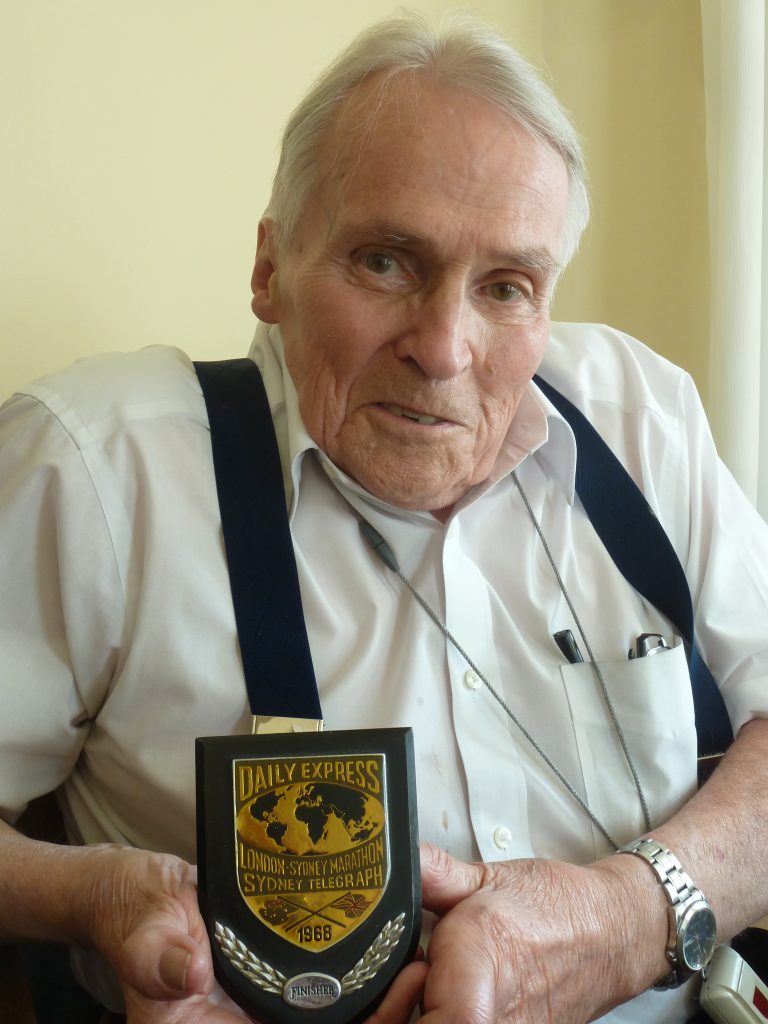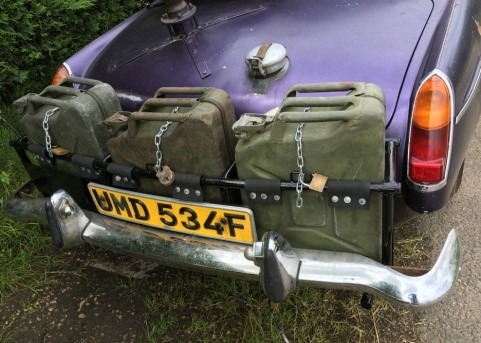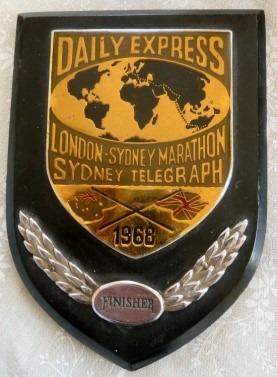
Dr Tom Boyce
Co-Driver
Co-driver for Jean Denton.

Co-driver for Jean Denton.

The Marathon MGB was invited to be displayed on the Historic Marathon Rally Group stand at this years Classic Car Show.
As the Marathon MGB is a runner it was decided to drive it to Birmingham this would be a real test of the car.
I collected the car from Kimber House at 9am on the Thursday and started up theA34 to the Small service station before the M40. Here I was met by David Scothorn who was going to be the backup car. We then got onto the M40 and agreed to stop at Warwick Services. I started off at a gentle speed around 50mph but as I got a bit more confident with how the car drove we got up to 65mph and even overtook some lorries on the outside lane. One problem was keeping an eye on passing cars that would start to overtake and then slow up to look at this strange looking MGB.
After a quick stop at Warwick we continued up the M40 our aim was to be at the NEC between 10am and 12pm. We eventually turned off at J6 of the M42 and joined the queue of display vehicles trying to get in. We arrived on time at Hall 8 and we were met by the other London to Sydney Marathon cars being displayed.



| After a very successful show it was decided to return on Monday morning to collect the MGB and drive it back in daylight, Hall 8 looked massive with just 2 cars still there. The return journey to Abingdon went well and the Marathon MGB is now on display back at Kimber House in Abingdon, if you are close by go and have a look at this very special car. JW |
The October Bicester Heritage Scramble on Sunday 7th October 2018 was the first time we had driven the Marathon MGB for more than a few miles under its own steam, since we found it in a scrap yard in 2015. Until now the car had been trailered to all the previous events.
The journey from Abingdon to Bicester was slow, as we were running in the rebuilt engine and the overdrive was not working.We discovered a couple of oil leaks from the upside down oil filter also the tappet covers, these could be fixed quite easily. As the car has no carpet and trim it was quite noisy but interesting.
When on display with the other MGB Register cars visitors seemed very interested and wanted to ask questions about this very special MGB.



With the MGB Register interest in the London to Sydney Marathon MGB, we thought as it is the 50th anniversary of this 1968 event we would have this as the subject for our 2018 Lecture.
(more…)
The MG Car Club – MGB Register, London to Sydney MGB restoration is coming on well. Over the last few weeks the car has been on display at MGLive, Bicester Heritage and a very special day for Marathon cars at Gaydon.
Our main aim when at these events is to get more information on the car and also to seek donations to the restoration. We have recently received a cheque for £250 from a person who saw the car at MG Live. We also received a cheque from a MGCC member in Australia for £100 who had watched the cars on the event in 1968 and our friends at MG Newbury have donated £100. All donations large or small are gratefully received.
All the main structural work has been carried out by Steve at Abingdon Car Restorations. The car now has new floors, sills, chassis rails and the cross members have been replaced or repaired with thanks to BMH for all the body parts.
Many thanks to Malcolm Sayers, Tony Gilbert and Dave Cato for re-building the engine and gearbox which are now ready to go back in the car. Prior to this we have decided to respray the engine compartment to a fresh British Racing Green. Our next task is to get the brakes, fuel and wiring checked so we can get the car to an MOT standard. Finally when funds are available we will respray the MGB back to the Gold and black colour as it was in November 1968 at the start of the event.

One major appearance change is the manufacturing and fitting of the Jerry cans, this is thanks to Bob and Steve. We have discovered that only 1 can had fuel the other 2 carried water which was fed into the cabin by plastic tubes. To complete the rear we need a Cibie lamp type 33, these were very thin lamps produced in the 60’s by Cibie. If anyone sees one please let us know.

We recently had a call from Tom Boyce’s stepdaughter Emma, who has finalised his affairs following his death earlier this year and she has donated to the project Tom’s finisher’s plaque and a few other items These will soon go on display in a dedicated display case at the MGCC HQ in Abingdon.
Many of you will know of the project which the MGB Register undertook at the beginning of last year when we discovered the MGB Marathon Car languishing in a scrap yard. This car took part in the Daily Express sponsored London to Sydney marathon rally in 1968 to drive a 10,000 mile course in 10 days.
It was driven by Jean Denton, later to become Baroness Jean Denton, and Tom Boyce. An amazing journey to undertake particularly when you consider the small budget available for the preparation work, which was completed by Tom, and Jean’s husband Tony, in a mews garage, assisted by Pete Smith. Pete has come forward and is advising with the restoration. The event attracted some 100 cars with the MGB managing a very credible 49th place and being the first sports car to complete the course.

Last minute preparations to the marathon car in 1968
The car when found was in a very poor condition, having been stored for 15 years. When it was discovered it required a considerable amount of work to save it. It was decided by the Register that this MGB was so important in a historical sense that we would do our best to restore it to a usable condition. This was not to be a full nut and bolt restoration because there is so much about it that that evokes a well-used rally car, along with the patina of age that should be retained.

The Jean Denton and Tom Boyce MGB leaves London on the start of the 1968 London to Sydney Marathon
We have been very fortunate in receiving a lot of help from companies involved in the classic car industry, for example BMH, Moss, Abingdon Restoration, Classic & Modern, Pat Jerome, Moto Lita and Burghfield Starter & Alternator Centre to whom we are very grateful. There has also been lots of work completed on the car by Club Members. Malcolm Sayers and Tony Gilbert have undertaken the task of rebuilding the engine for us and Dave Cato has got involved in the rebuild of the gearbox and the badly damaged overdrive unit. So there has been lots of progress made since the discovery of a very sad looking MGB early last year.


Now we are looking for your help please; we need funding to complete the project. If you can spare a few pounds please contribute towards the restoration. The respraying back to the original Nova Gold with the distinctive matt black bonnet will be The Jean Denton and Tom Boyce MGB leaves London on the start of the 1968 London to Sydney Marathon expensive if it is to be completed to the standard that we believe it should be. A donation of £25+ will enable your name to be displayed on the information boards along with the car. Details can be found at www.mgb-register.org
The plan for the car, which is owned by the MGCC, is for it to be displayed at various events. It is destined to be on the MGB Register stand at MGLive! at Silverstone in June. Both the National Motor Museum at Beaulieu and the British Motor Museum at Gaydon have expressed an interest in displaying the car as part of major exhibitions planned over the next few years. 2018 will be the 50th anniversary and a special event is being planned by the Historic Marathon Car Association.
Should you require further information please contact the Project Leader, John Watson on 07770 575236 or email john.watson@mgb-register.org who will happily answer any questions that you may have.

The 1968 London to Sydney Marathon MGB is progressing well and will be on display at the MG Car Club stand at the NEC Classic Car Show this month, although it is a long way from completion as you will see from the pictures.
I am sure you read the words written by Robert Connor in last month’s SF on the life of Tom Boyce who passed away in August. Tom was so instrumental in building this special MGB for Jean Denton and him to compete in the adventure. The other person who helped Tom was Pete Smith, who was recently told about the car being saved. He contacted me and we met at Kimber House in September. Pete gave us some fantastic extra information on the special features fitted, we then took him to Abingdon Car Restorations where the MGB is at the present and he was amazed as to how original it still is, Pete has agreed to assist us as a special advisor to the project.
With the kind support of British Motor Heritage we have the required body panels which are needed to get the car ready for the MOT check and as mentioned in previous SF notes the engine and gearbox have been removed and are being checked over.
More help came from MGB owner Bob Burley who offered to produce the “Roo-bars” for the front and rear of the car, we also had some Cibie lamps donated by MGB owner Brian Wyld. We cannot say how much we appreciate the personal help and enthusiasm we are receiving from everyone.
To see photographs of the car on the event and in its current condition go to our website and follow the link.
As with this type of project we do not have a bottomless pit of pound notes so as announced at MG Live we are asking members and others who would like to support the rebuild by donating a minimum of £25 per name to the project. For this your name will be displayed with the car on completion of the restoration. This can be done by visiting www.mgb-register.org and follow the link as to how to make a bank transfer and to submit a donation form. If you wish you can send a cheque made payable to “MGB Marathon” and post to the MGB Register Treasurer, Geoff Edwards, 25 Hayters Way, Alderholt, Fordingbridge, SP6 3AX, together with a note of your name, address and email address with contact telephone numbers. We must also thank the MG traders and suppliers who have also offered help with products and services. These are Abingdon Car Restorations, BMH, Moss Europe, Steve Illing, Bob Burley, Pat Jerome, Brian Wyld, Malcolm Sayers and David Cato and Pete Smith, I am sure this list will increase as we still have many more things to complete, such as new tyres, a wiring loom, competition driving seat, new discs and brakes etc etc. And a respray to the original gold colour the car was when competing on the event.
UMD 534F – 1968 London to Sydney Marathon MGB
Following the purchase of the MGB we have discovered many various interesting items about the car and the event.
The Daily Express London to Sydney Marathon was the idea of Tommy Sopwith and Sir Max Atkin, Tommy a racing driver and Sir Max the Chairman of Beaverbrook Newspapers and a powerboat racer.
They called in Jack Sears the racing / rally driver to help with the organisation of the event, the idea was 10,000 miles in 10 days with the first prize being £10,000.
98 cars left Crystal Palace at 2300 hrs on the 24th November to tackle the first leg of 7,000 miles, with 72 cars arriving in Bombay on 1st December to board the SS Chusan and cruise across to Perth on 15th December in Australia to continue the last 2,500 miles to Sydney by the 18th December.
Details of the route and various photographs of the car on the event and now are available to view on our website www.mgb-register.org
The MGB was crewed by Jean Denton and Tom Boyce, sadly Jean; latterly The Lady Denton of Wakefield passed away aged 65 in 2001. Tom now lives in Guildford and I together with Roger Boys had a very interesting 2 hours with him, where he told us his story of how he built the car. A new MGB shell in British racing green was delivered to the London mews garage where Tom lived, it had come via Abingdon Special Tuning where we believe it had been seam welded.
Tom, a Canadian, had studied mechanical engineering in Toronto and at the Imperial College in London where he gained a doctorate in Engineering, his expertise was in improving the efficiency of the internal combustion engine, so he built the MGB engine which he balanced with a lower compression ratio than normal with standard pistons and a semi race cam. They were uncertain as to the quality of fuel they would be using, although they had a total fuel capacity of nearly 30 gallons with the extra tank in the boot and 3 jerry cans on the back.
To assist with the extra weight on the back of the car the, standard lever arm shock absorbers were upgraded to adjustable models, also fitted were extra telescopic springs with rubber top mounts developed by John Moulton for Tom, which fixed in mounts in the floor of the boot.
As they would be driving up to 1,000 miles a day it was decided to replace the passenger seat with a reclining bed, this was designed by the London Orthopaedic College and was tilted at 6 degrees, the driver’s seat was a bucket racing seat with a high back.
Tom took great delight in telling us of their secret weapon. Around the corner from the garage was the Ladbrook Grove Police station, the coppers would walk round most evening to see what work had been done, on the day before the event they made Tom and Jean horary police men and fixed a special police federation badge on the windscreen.
At MG Live this year where the car was displayed the MGB Register were asking MGCC members how they would like this special MGB to be restored, it has been decided that we should ideally make the car structurally safe and road worthy so it can be driven to MGCC events in the summer months with it maybe being displayed at the National Motor Museum at Beaulieu or the British Motor Heritage at Gaydon during the winter months.
We have formed a project team to oversee the rebuilding and work that will be carried out on the car over the next few months, a draft budget has been prepared to control and monitor the costs. We have been very fortunate that various trade companies have offered us support and products that will be required, initially we must thank John Yea at British Motor Heritage for allowing us to store the MGB at Witney where we have been able to carry out the first part of the rebuild, also Matthew Hutchins at Moss Europe for their support with parts for the project.
Other items that have been donated is a Works Hard top in white also some Cibie lamps.
We are asking for donations to help restore the car with a minimum payment of £25 for this you will have your name displayed on a board under the bonnet or boot. We have opened a special new bank account for the accountancy of the restoration.
If you would like to contribute to the car please fill in the bank transfer and donation form that will be on the MGB Register web site shortly.
If you have any knowledge of the car or would like to get involved in its rebuild please contact John Watson on 07770 575 236 or email chairman@mgb-register.org